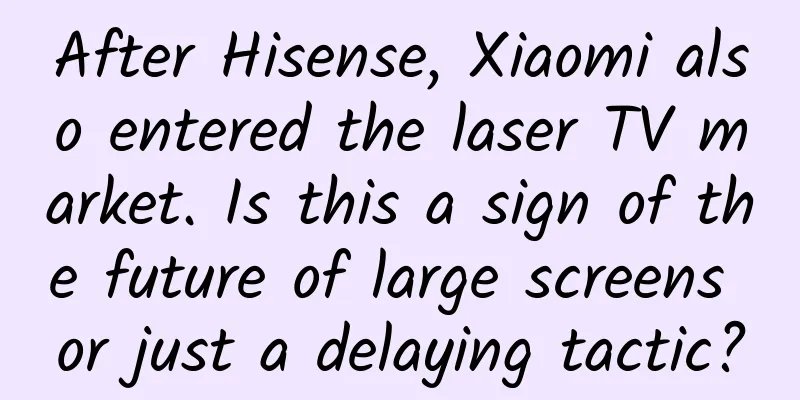After Hisense, Xiaomi also entered the laser TV market. Is this a sign of the future of large screens or just a delaying tactic?

|
While the TV industry is arguing over whether OLED technology can become mainstream, the sudden rise of the laser TV concept has apparently become a new disruptor in the big-screen era. Following the traditional TV brand Hisense's high-end product line layout with laser TVs some time ago, Xiaomi also held a new product launch conference in Beijing on June 28 to officially launch the new laser TV products under its ecological chain brand Mijia. Is the era of laser TV really here? It may not be that simple to remove the back of the TV screen. TV manufacturers' transformation into projection panels leads to price fluctuations Since the second half of 2016, due to factors such as the rising costs of LCD panels and component procurement, the profit margins of many TV manufacturers have been extremely squeezed, and some are even selling at a loss. For example, the financial report released by Hisense Electric in the first quarter of this year showed that the company achieved operating income of 6.703 billion yuan, a year-on-year decrease of 5.98%. It was also because of the sharp drop in profits in the first quarter that on the first stock market trading day after May Day in 2017, the stock price of Hisense Electric, which has always performed steadily, also experienced a rare limit down. Some industry insiders analyzed that this was related to the increase in TV manufacturing costs. Take the 42-inch perforated panel as an example. The unit price reached $150 in December last year. Faced with huge pressure, many TV manufacturers chose to adjust their strategies and began to raise prices. Even Internet TV brands such as LeTV and Xiaomi, which are known for being price killers, have changed their product prices several times within a year. Laser TV lacks industry definition and price killer needs to be viewed calmly Obviously, we can understand the launch of laser TV as a delaying tactic made by traditional TV manufacturers to deal with the rising cost of screen panels. The reason why laser batteries have become the choice of many TV manufacturers is that the industry currently does not have a sufficiently objective and accurate definition of them, making them a good category for product transformation. Although the Xiaomi Laser TV does use laser light in terms of product technology, it was still ridiculed as a "projector" by the industry after the launch conference. Many people question whether one can buy a true laser TV for 9,999 yuan. An interesting phenomenon is that Hisense, which had previously released a laser TV, congratulated Xiaomi for its "vision" before the press conference on June 28, but changed its words after the Xiaomi laser TV product was unveiled, saying "Laser micro projector is not laser TV." You should know that the current laser TV on Hisense's official website is priced at 79,999 yuan, which is almost eight times that of Xiaomi's laser TV. It is definitely not acceptable to ordinary consumers. However, the 4K resolution it can achieve is also a standard that the current 1080P Xiaomi laser TV cannot reach. In this regard, we interviewed the screenless TV manufacturer Xgimi about its views on the Xiaomi laser TV. Guo Xueqing, public relations director of Xgimi screenless TV, said that the configuration of the Xiaomi laser projector and its price of less than 10,000 yuan reflect the product's positioning as an entry-level laser projector. Guo Xueqing also believes that whether it is Hisense or Xiaomi, even if they launch laser TVs, these brands will still mainly promote traditional TVs in the market. This is different from the brand strategy of brands like Xgimi, which has focused on screenless TVs from the beginning. In the high-end market, for brands that have both flat-screen TVs and laser TVs, it is inevitable that there will be a fight between the left and right hands. However, this does not mean that it is meaningless for Xiaomi to launch a laser TV that can only be explained as a "laser micro-projector". After all, at this stage, laser TV is still a niche product of new technology, with high manufacturing costs and user popularization thresholds. When more and more brands enter this field, although it is currently impossible to predict when the laser TV market will explode, it will still play a positive role in changing this situation. As a winner of Toutiao's Qingyun Plan and Baijiahao's Bai+ Plan, the 2019 Baidu Digital Author of the Year, the Baijiahao's Most Popular Author in the Technology Field, the 2019 Sogou Technology and Culture Author, and the 2021 Baijiahao Quarterly Influential Creator, he has won many awards, including the 2013 Sohu Best Industry Media Person, the 2015 China New Media Entrepreneurship Competition Beijing Third Place, the 2015 Guangmang Experience Award, the 2015 China New Media Entrepreneurship Competition Finals Third Place, and the 2018 Baidu Dynamic Annual Powerful Celebrity. |
>>: Link Motion Announces Strategic Investment from China AI Capital Limited and Board Adjustment
Recommend
Can't wash away the "lead" powder? If you can't wash it away, then use it to cover your face!
"The hair is loosely tied up, and the makeup...
How to use the points system to stimulate user retention (Part 1): Classification and definition of points
The so-called points system is based on points. B...
Renewing domain name for a long time is helpful for ranking
In a patent application filed by Google in Decemb...
2022 Lithium Battery White Paper: Lithium Battery Recycling, a Promising Future
1. Based on commercial reality, it is expected th...
Experts use UC information flow, how to deliver UC headlines?
Mobile information flow ads have been very popula...
Large capacity, zero attenuation, CATL Tianheng energy storage system released
On April 9, CATL released the world's first e...
Nobel Prize winner George Parisi: Flying with the starlings, doing what no one has done before
In 2021, Italian physicist Giorgio Parisi won the...
A brief analysis of the HTTPS principle and its use in Android
[[192101]] This article first analyzes the securi...
Personal pension is coming, will my pension increase?
Mixed Knowledge Specially designed to cure confus...
Is the Pacific Ocean getting fresher and the Atlantic Ocean getting saltier? | Expo Daily
The Pacific Ocean is getting fresher and the Atla...
This molecular mechanism allows plants to "control their mouths"
Produced by: Science Popularization China Author:...
In the second half of the Internet, will the traffic dividend disappear? There are 3 operating directions
In a speech this year, Xing Ge mentioned that aft...
Using data from 41 solar occultations, the mystery of Saturn's rings was finally discovered?
Sun reveals secrets of Saturn's rings Saturn&...
How do merchants choose the WeChat mini program platform?
As mini programs continue to develop, many busine...









